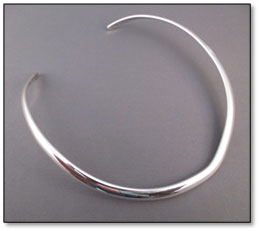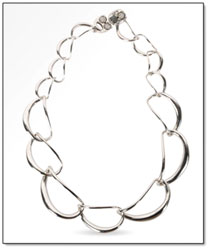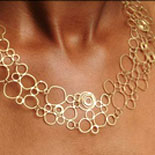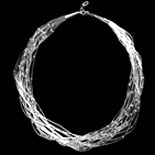By Katarina
For the club competition we can either make a necklace or a bracelet. In the past we have shown you the beautiful necklaces made by Mary Lancaster. I look at them and see the beauty and work and certainly appreciate them but they are not my style.
They might not represent your style either so I wasted some time on your behalf and looked for alternate styles:
For the purpose of the competition the piece has to be made of silver or gold with no more than 25% copper for accent purposes allowed (that is optional). And no stones either this year.
Necklace length definitions:
1. Collar – Collar necklaces sit flush against the skin and rest directly above the collarbone. Contemporary collar necklaces are thick and look similar to a collar on a shirt, measuring anywhere from 12 to 16-inches (30 to 40cm).

Figure 1 – Sterling Silver Collar
2. Choker – The choker necklace can either sit very high on the neck or just below the collarbone. The later style dangles more freely and is slightly longer in length. (16 inches/40cm)

Figure 2- Sterling Silver Choker

Figure 3 – Starburst Choker
3. Princess – defined either by their length or style. The length is longer than a choker but shorter than a matinee necklace. The 18-inch (45cm) length is thought to be the most universal and flattering length. Any pendant or focal piece will usually rest right below the collar bones.
4. Matinee – Matinee necklaces are great for jewellery layering because they are longer than princess length and shorter than opera length. These necklaces will fall somewhere between the collarbone and the centre of the bust. (22 inches/ 55 cm)
5. Opera – long and versatile. When they are worn as a single strand, the necklace should fall below the bust line. Some longer opera length necklaces may even reach the bellybutton. (30 inches/ 76cm)
6. Lariat – also known as a rope or Y-necklace. In terms of length, this necklace is longer than opera length; doesn’t have a clasp. The chain or beads form a long rope that is either tied or pulled through a circular finding like the one pictured here. (Ave. length: 34 inches / 86cm)

Figure 4 – Lariat Necklace
Necklace style definitions:
1.Bib – usually collar or princess length. They consist of a wide front portion that rests just below the neck. Pearls, beads, or gemstones are often sewn or set into the bib, creating fanciful designs along the circular or triangular frame.

Figure 5 – Bib Necklace
2. Lavaliere – a feminine pendant necklace that connects a dainty chain to a larger focal piece. That main pendant also has smaller embellishments dangling from it. This necklace style was popular during the Art Nouveau, Edwardian, and Art Deco jewellery eras. These delicate pendants look best with light, feminine, and even bohemian fashions. They are usually princess length and will sit right below the collarbone, so any neckline will work well.

Figure 6 – Lavaliere Necklace

Figure 7 – Locket
3. Locket – a small compartment pendant that can hold a small picture or memento. These pendants are personal, sentimental, and are often passed down for generations. Lockets were popular during the Victorian era and were often engraved and filled with a loved one’s hair. Lockets look best with opera length chains but usually come standard with an 18″ princess chain. Pair a longer locket with a minimal necklace that is choker length.

Figure 8 – Pendant
4. Pendant – can come in many shapes and styles. Pendants are focal points that dangle off a chain of any length. Popular pendant styles include lockets and lavalieres. Pendants are easily personalized. Initial pendants make great gifts and are often worn close to the heart.
There are more styles but I have left them off as they are defined by the use of stones and pearls and so not suitable for our competition.
Reference
- Figure 1 – Sterling Silver Collar by Artie Yellowhorse
- Figure 2 – Liquid Chain Choker – by Louise Olsen
- Figure 3 – Starburst Choker
- Figure 4 – Lariat Necklace
- Figure 5 – Bib Necklace
- Figure 6 – Lavaliere Necklace – by Kristin Ash. Why not replace the spinner with a wire sculpture
- Figure 7 – Locket – you would have to make the locket too.
- Figure 8 – Pendant












We hope this will give you some ideas and inspiration to participate in the competition. If you are not sure if your idea will work, why not contact one of our instructors or talk to any of us to discuss. And remember, you still have plenty of time.